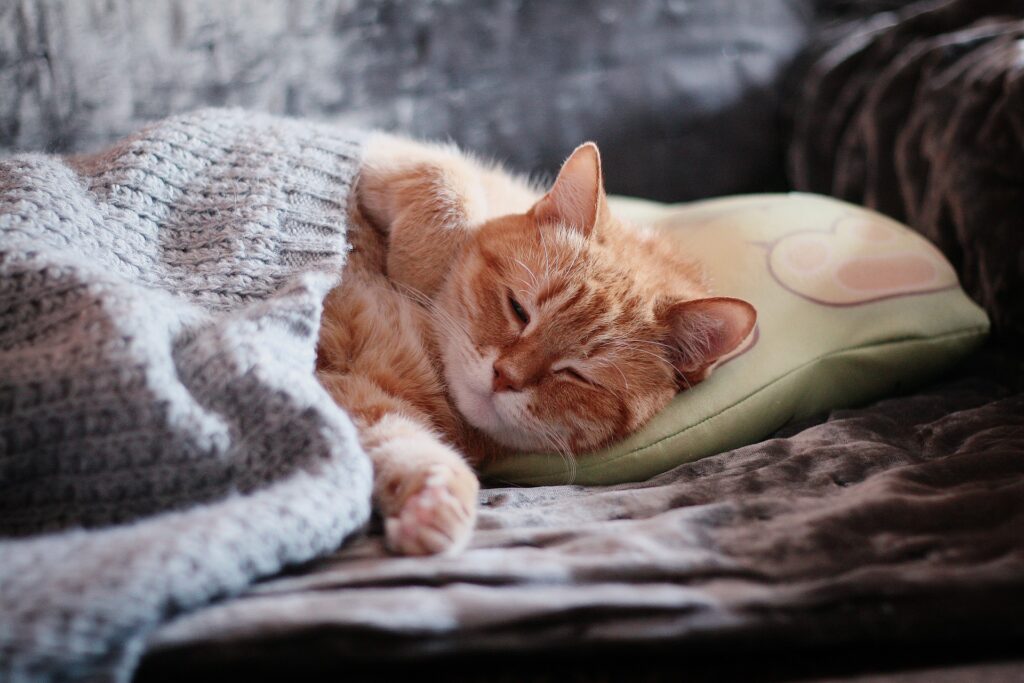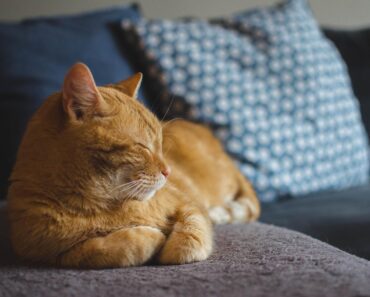
Many whiskered pets ignore the more expensive litter boxes altogether, preferring an ordinary box. If the sight of the box is hurting your sense of beauty, find out where and why cats like to sleep before you look to replace them. Once you’ve got the basics down, it’ll be easy to set your cat up in a new sleeping space and figure out where she should be kept out of the way.
How cats choose where to sleep
Before we list the places cats usually sleep, let’s first look at what makes them choose. This explains the frequent neglect of the cat house purchased.
Time of Day and Year
Most whiskers are active at night or just after dusk. Only a few will follow their owner’s routine. These animals prefer to snooze in a nearby area because of the affection they have for their owners. All other cats will choose their spots according to the time of day:
- During the day – as sheltered as possible to recover during the deep sleep phase;
- In the evening – more visible for a quick and reactive sleep.
Another important factor is the time of year. Many owners have noticed that their pets migrate periodically. This is related to the weather. In the winter, they snuggle up next to the heater or a person, while in the summer, they stretch out on the tiles or in the bathroom.
The colder it is outside, the higher the cat will lie. This is because cold air is concentrated underneath and warm air, which is much lighter, is concentrated above.
Lighting
Sunlight plays an important role. The movement of the sun indicates where a cat will sleep at a certain time of day. In search of warmth, the mustachioed cat will migrate through the house, choosing the warmest spots.
Artificial lighting is equally appealing. Many cats like to snuggle under a table lamp. Unlike floor lamps and chandeliers, it allows you to get as close to the heat source as possible.
Emotional context
Emotions are also important. Sick animals often hide in the most inconspicuous corners. Healthy, active animals prefer to be out in the open so they can escape and attack at any time.
And sleeping together will vary depending on how attached you are. The more your cat trusts you, the better she’ll sleep.
Height and isolation
When talking about where and why cats sleep, it’s impossible not to mention cabinets and boxes. Where they sleep, cats are attracted to height, and the places where they sleep are isolated. Both are important for safety. A closet provides an excellent view to prevent sudden infiltration, while a box leaves only one side to attack, reducing the area to stalk the enemy.
Of course, no one will attack a pet – but in this case, it is subject to instinct. It’s an ancient genetic “habit” that is almost impossible to eradicate. And why should we?
Co-sleeping between owner and pet
The love of co-sleeping evolves on its own or is nurtured through education. Co-sleeping has its advantages and disadvantages. Therefore, it is best to stick to your own preferences. For safety’s sake, an animal can always be accustomed to one sleeping area.
The only nuance is the age of the pet. The older they are, the longer it will take to get them used to sleeping separately. That’s why it’s a good idea to weigh the pros and cons before getting a kitten.
Where should a cat or kitten sleep?
Deciding where a cat sleeps from the start can eliminate many of the problems associated with bed weaning. Some pets will sleep with their owner because of space limitations. If you don’t want to share your cat’s bed, make sure he has his own space, following the criteria above, and yell at him if he tries to sleep there.
Can I let my pet sleep in my bed?
There is no simple answer. If you love your pet, you can’t do without it. The only exception is if there are contraindications.
The harm of sleeping together
Sleeping in the same bed is not dangerous in itself, but it is contraindicated for certain groups of people. These include:
Children under the age of 3 with weak immune systems;
Owners who suffer from sleepwalking or restless sleep, which can cause unintentional injury to the cat sleeping next to them;
Pregnant or nursing women with temporarily reduced immune systems;
people with allergies.
Special mention should be made of the period of illness of the pet. If your pet is infected with a disease that is transmissible to humans, you should avoid unnecessary, unprotected close contact and co-sleeping.
The benefits of co-sleeping
In addition to receiving pleasant emotions, co-sleeping relieves fatigue and stress. This is the effect produced by the vibrations of a cat’s ear.
There is also the belief that the parts of the body where the cat lies down do miracles. This is close to superstition, but there is some truth in it. The fact is that our mustachioed cherubs choose the warmest places, that is, the areas of hyperthermia. Their purring relieves the general condition of the patient, but it cannot cure a serious pathology.
Where do cats usually sleep in the house?
After determining where and why cats like to sleep, let’s see what exactly a cat corner should look like. In addition to the most attractive places, it is advisable to pay attention to those that can be dangerous.
Which areas need better equipment
Let your pet’s preferences guide you. Look at the areas where he often rests and do what you can to make him feel comfortable and safe.
If he likes a little height, give him his own space on a closet or windowsill and add a soft blanket or bed from the store. If he prefers a more secluded spot, such as a laundry basket, buy a cozy cup-shaped bed from a pet store. A wicker basket or , which you can decorate to your liking, is also suitable in this case. The most important thing is to keep the interior warm, dry and clean – each bed should be cleaned periodically and washed with unscented cleaners.
A place where the cat can not enter
Despite the displeasure of the cat, it is recommended to stay away from certain places. These include:
- A baby’s crib ;
- the bedroom of a person with allergies;
- the kitchen unit and dining table;
- eaves if there are no cat nets;
- a carpet in the hallway containing a lot of dirt and germs;
- washing machine;
- A system box, which is often damaged by cat hair due to overheating.
All of these situations pose a risk to the health of the pet and its owners, as well as to their property. Prevent your pet from sleeping in restricted areas from the first days of its life. Special repellent sprays, citrus peels, crumpled aluminum foil and tape are suitable for this purpose.
What does it mean to choose unusual locations and poses?
In addition to the standard locations, there are also unusual locations, but again, the same rules apply. Most often, cats nest on:
- a shelf with clean clothes in which they can bury their heads to hide ;
- a stove or system box that gives off a pleasant heat;
- bags and pouches that are as protective as a box;
- a bathroom sink that cools your fluffy butt and gives you a view;
- a bed under a plaid that smells good and keeps your favorite owner warm in winter;
- a computer chair or a chair recently warmed by man.
Exotic feline poses are also amazing, as they take up most of the cat’s phone memory. Looking at them reveals their emotional context and health status:
- lumpy – saving energy;
- an open belly – a demonstration of trust and affection for the owner;
- Sprawling in a confined space, pinching its paws and covering its nose – an attempt to warm up or be sick.
In the latter case, it is advisable to consider the accompanying symptoms. If your pet is unsociable, does not eat much and constantly hides in the darkest corners, ignoring the common games, have him checked by your veterinarian.
Conclusion
Knowing where and why cats sleep can help you avoid many mistakes, including buying a whole collection of unnecessary beds. When choosing a personal space for your pet, be sure to consider their interests. A sense of beauty is a good thing, but it will not be appreciated if it excludes most of the criteria that are important to your cat.






